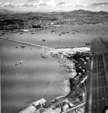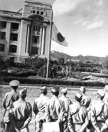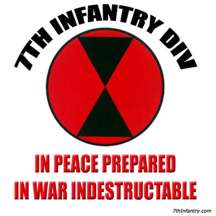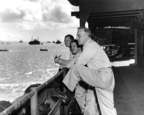|
|
But not in 1950, in 1945
Inchon Landings!
By Milo Smith
Click
any image for larger view
|
While re-reading the bio on Ben Benedetto I remembered
something that happened to our company soon after we landed at Inchon,
Korea on September 8, 1945.
I left Pearl Harbor on July 3, 1945, for Eniwetok
Island in the Marshalls. We then took off to an Island rest stop, Mog
Mog, familiar to many GI's. I arrived on Okinawa in late July or early
August. As I remember, the ship encountered a typhoon off Okinawa on
July 29, 1945.
The campaign for Okinawa began
on April 1, 1945. The island was declared secure on June 21st. I
became the squad leader as a staff sergeant.of the 10th Army, 24th
Corps, 7th Infantry Division, 32nd Infantry Regiment, 2nd Battalion,
Company B, Mortar section.
After arrival on Okinawa our daily routine consisted of training
and going on patrol in the daytime and watching the Kamikaze's diving
on ships in the harbor in the late evening and at night. We took
training also for the invasion of the Japanese mainland which was
scheduled to begin on November 1, 1945. We were very thankful for
the bombs |
 The destroyer USS Mullany, hit by a Kamikaze
pilot flying a Nakajima 43 fighter. The pilot was still in the
plane when this picture was taken. This is an official US Navy
photo. This occurred on April 6, 1945. This ship was one of 25
Naval ship damaged or destroyed during the Okinawa campaign by
Kamikaze planes (see
below).
The destroyer USS Mullany, hit by a Kamikaze
pilot flying a Nakajima 43 fighter. The pilot was still in the
plane when this picture was taken. This is an official US Navy
photo. This occurred on April 6, 1945. This ship was one of 25
Naval ship damaged or destroyed during the Okinawa campaign by
Kamikaze planes (see
below). |
| As you know, Korea
had been occupied by the Japanese since 1905 at the end of the Russo-Japanese
war. We boarded a ship on September 3, 1945, and arrived at Inchon
Korea on September 8, 1945. The reason I can state some of these
dates is I still have every one of the letters my mother wrote to
me while in the service. On the day of our landing in Korea, we
loaded into Higgins boats and circled near the harbor until the
30-foot tide came in. After our company landed, we marched to a
former Japanese Military Barracks that had just been vacated by
the Japanese |

Inchon Landings September 6, 1945 |
|
within the last few hours.
Immediately upon entering the barracks, guess what we saw so recently
inscribed on the walls of the barracks; you guessed it "KILROY
WAS HERE," along with the usual face peering over the wall.
We rode a train to Seoul the next day and upon arriving there,
were sent to an allied prisoner of war camp, filled with English
and Australian prisoners of war. We sent them out to hospital
|
ship, then spent about two
days there. I remember seeing a warehouse almost full of Red
Cross packages, which had never been given to the prisoners.
My stay in Korea took me over
to the east side of the country to a little town by the name
of UtChin where we spent the winter of 1945-46. In the early
spring of 1946 we moved to an isolated location north of Seoul
immediately south of the 38th parallel. Here we daily monitored
the passage of refugees across the parallel, mostly from north
to south.
|
 Lowering the Japanese flag at Surrender
Cerimonies Seoul Korea September, 1945
Lowering the Japanese flag at Surrender
Cerimonies Seoul Korea September, 1945 |

Surrender of Japanese Forces in Southern Korea September
1945
|
I stayed in UtChin until I left Korea
on August 22, 1946. After leaving Korea on an APA (troopship)
we stopped for a short time in Yokohama, Japan and then across
the Pacific to Seattle Washington. From Seattle we went to Fort
Sam Houston at San Antonio, Texas. The effective date of my discharge
was October 30, 1946, though I actually came home before that.
My military service lasted 1 year, 11 months, and 28 days, from
November 3, 1944 to October 10, 1946.
|
See
Ben Benedetto's story of the first GIs in Korea

Send Corrections, additions,
and input to:


Click
the star for
Site Map  .. ..
|
|





